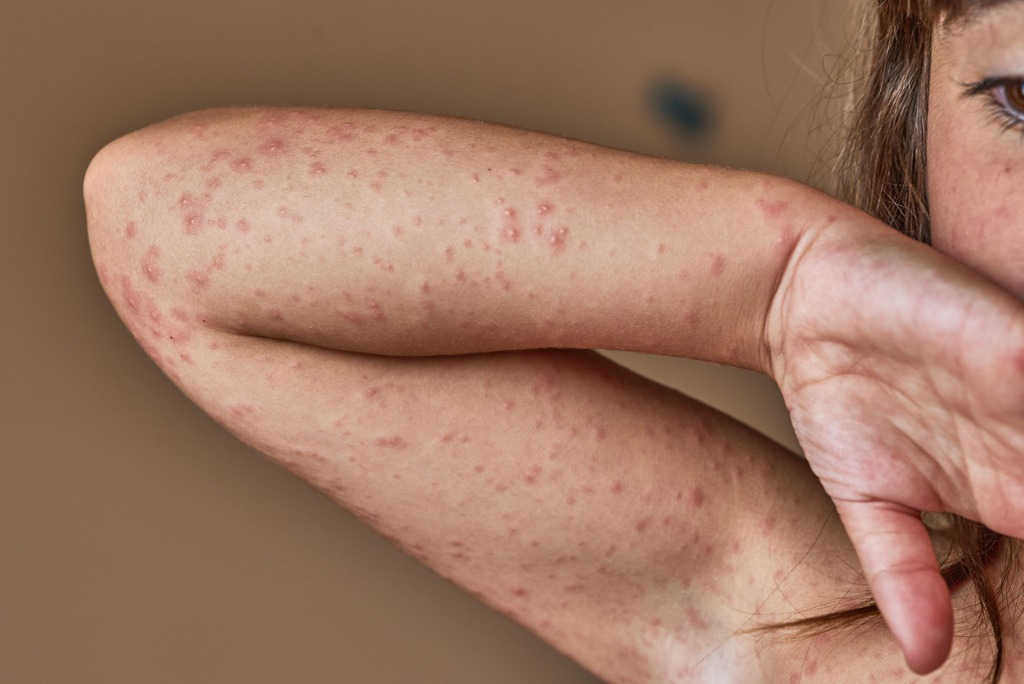Prurigo nodularis (PN) is a rare skin disorder that causes hard, itchy, or painful bumps to appear on the skin. Symptoms of PN usually begin to appear in middle-aged adults, but it can affect people of all ages.
What Does Prurigo Nodularis Look Like?
The primary symptom of prurigo nodularis is the appearance of firm, itchy or painful lumps called nodules on the skin. These nodules may cause scarring and typically form between 1-5 cm in size, pea-sized or larger. The nodules are typically red or brown in color, hard, covered in thickened skin, and may show signs of scratching such as fissures.
Other symptoms of prurigo nodularis include:
- Burning or stinging sensations
- Dark or light scars on the skin due to scratching
- Extreme pruritus that causes difficulty sleeping
Nodules as a result of prurigo nodularis can appear anywhere on the body but are more common on the extensor surface of the arms and legs.
Causes of Prurigo Nodularis
While the exact cause of PN is unknown, those with a history of eczema, lymphoma, kidney disease, liver disease, anemia, pregnancy, stress, insect bites, or an HIV infection may be more at risk. The itching associated with PN is so unbearably severe that it can only be relieved by scratching to the point of damaging the skin. Nodules form when the skin is repeatedly scratched and irritated.
Prurigo nodularis is likely not passed down through families. However, genetic abnormalities or other health problems may be involved in the condition.
The Itch-Scratch Cycle
The itch-scratch–cycle is a vicious cycle whereby itching leads to scratching, and scratching causes secondary changes in the skin that then lead to more itching. Those changes include the release of inflammatory cytokines, antihistamines, and increased sensitization of the nerves that send the itch signal back to the brain.
An additional theory is that those with PN have thickened nerves in the skin, and these nerves are thought to send signals to the brain, causing itchy sensations. In addition, scratching the skin may cause more nodules to form and, in turn, cause the nerves to thicken further, sending more signals to the brain and causing further itching. Unfortunately, what causes the itching, to begin with, is not clear and may vary from person to person.
How Prurigo Nodularis is Diagnosed
When diagnosing PN, a doctor may perform a skin biopsy to look for signs of the condition, such as thickened skin and inflammation. In addition, blood tests can help rule out other conditions causing a person’s symptoms, such as lymphoma and kidney disease.
Treatments for Prurigo Nodularis
Although there is no cure for prurigo nodularis, there are ways to help relieve symptoms and reduce itching. The first step to treating PN is to minimize scratching. Itch relief can be aided by wearing loose, cotton clothing and using a mild moisturizing ointment to moisturize the skin.
Corticosteroid creams can be applied to the affected areas and help reduce itching in those with PN. In addition, ointments with menthol or phenol can be used to cool and soothe the skin and help stop the urge to scratch.
Other possible treatments include:
- Corticosteroid injections
- Oral antihistamines
- Selective serotonin reuptake inhibitors (SSRIs)
- Capsaicin cream
If these treatments do not provide relief, cryotherapy and light therapy may be beneficial. Cryotherapy uses extremely cold temperatures to help reduce the size of nodules. Light therapy, also known as phototherapy, uses UV light to help reduce skin inflammation and decrease itching.
These treatments are often paired with habit reversal therapy. Habit reversal therapy focuses on stopping the itch-scratch cycle and is often done in combination with other treatments.
Clinical Research on Prurigo Nodularis
Sometimes using topical creams, injections and therapy are not enough to put an end to your constant itching. If this is the case, clinical research studies may be a good option for you.
Through clinical trials, new treatments are developed and made available to those who need them. In addition, clinical trials are carefully monitored and typically allow participants to receive the treatment free of charge.
Contact Olympian Clinical Research
If you have moderate to severe prurigo nodularis and have tried other treatments without success, we want to hear from you. Olympian Clinical Research may be able to offer you or a loved one the next cutting-edge treatment for PN.
We are currently conducting clinical trials in the Largo Area. Contact us today and see if you qualify for a prurigo nodularis clinical trial.

Recent Comments